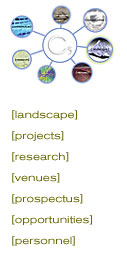 |
Datum
![]()
Jan Ekenberg
"This is a map that will take you somewhere, but when you get there you
won't really know where you are."
In current C5 research, datum appears as a crucial concept for the
understanding of information objects as a carrier of meaning in a data
flow. The denotative properties of the datum, i.e. its ability to relate,
reference, replace, retrieve, link, list and index information positions
the datum ontologically within families of linguistic agencies and can
therefore be examined and understood with analysis of syntagm, rhythm,
tropes etc. Despite the datum's obvious similarities to the sign, it
should not entirely be thought of as such. One important distinction is
the datum's ability to write itself, which relate it to the concept of
"unlimited semiosis" in which the Peircean interpretant, in the mind of
the interpreter, repeatedly becomes a sign. The animate character of the
datum also distinguishes it from the sign in the less animate, classical
writing with its connection/association to death, as a Derriderian and/or
classical idea i.e. sema over soma (Greek: sign/body).
Although conceptually complex, it is interesting to notice the 16
sessions' engagement with the process of translation or transformation,
which occurs on several levels in the project: data from To Not See A Thing
systematized within a system, "sessions" creating a map. Translation is always,
as often pointed out, an act of distortion or displacement, but when language
is made passive, during such an act, the datum has the ability to rewrite itself
during the process and escape the handling intact.
One way of studying the datum is to analyze it in specific topographies of
agencies and attributes; agencies and attributes as a proposed system to
"capture" the denotative power of the datum. The before so slippery and
erratic data units suddenly become tangible, comparable.
One problem occurs, however. The Datum is contextual and a framework,
scale or environment need to be specified for the datum to take on
meaning. Without association to an environment, the linguistic structural
coupling has no meaning and the datum is free to assume roles within an
alternative system.
This is one aspect of the datum, but the datum has dual qualities. As
well as data in general, the datum has another uncommon, and uncanny,
ability to manifest itself: both as a language-like bit, a linguistic
agency, and a structural object; a thing with attributes, an object in
the world.
This dual quality of the datum positions it in an interesting domain of
unifiers. The datum's ability to be twofold: language and object, creates
a possibility for the datum to somehow span the unbridgeable gap between
language and objects. The concept thus helps us understand how the objects
which someone perceives are transformed into language. As the objects are
given linguistic form, they also become commands and prohibitions.
-Robert Smithson